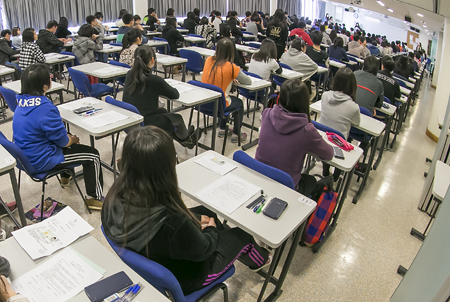This year, a record number of 4,155 students participated in UM’s admission exam. The seemingly simple admission process which includes only three steps for students—application, examination, and acceptance—actually involves a lot more work on the part of UM staff that can’t allow any mistake. This issue of My UM gives you an up-close look at the admission process.
Preparation of Exam Papers
Every year, the Registry works together with internal academic staff in the preparation of exam papers. The exam paper for each subject is prepared by one chief examiner, with the assistance of two to three examiners. The university appoints another group of academic staff to review the exam papers to make sure that they comply with the relevant examination syllabus. So a team of between 30 and 40 people are responsible for preparing and reviewing all the admission exam papers. The Registry plays the role as a coordinator and needs to make sure that everything happens on schedule. After the exam papers are ready, Registry colleagues will be stationed in the printing room for about three weeks to make arrangements concerning printing, proofreading, packaging, recording and double-checking to make sure that printing results, quantity and stapling of the exam papers are exactly as expected.
“This year 292,547 pieces of A4 paper were used for printing.” Vu Ka Wai, head of Registry, explains that due to space limitations, all the exam papers were stored in her office. “I locked the door whenever I left my office. One of my colleagues, who was responsible for coordinating exam papers, also had the key. We only give keys to those who don’t have friends or relatives sitting for the exam to avoid conflict of interests. All colleagues with access to the exam papers also need to sign a declaration of confidentiality.”
Grading of Exam Papers → Admission
After the exam papers are ready comes the most difficult part—making invigilation arrangements. Take this year for example, if all the exams take place at once, it would require 300 classrooms, 300 chief invigilators (usually administrative staff from academic units and Registry colleagues), and 465 assistant invigilators (usually postgraduate students), and would involve 13,129 attendances, but there are only around 100 classrooms on the current campus. “Invigilators represent the image of UM since they are the first to meet the students. To present a professional image, every year we would organise two briefing sessions before the exam to explain invigilation rules and code of ethics. We would also distribute instructions for invigilators,” says Vu.
The end of the admission exam doesn’t mean Registry colleagues’ job is over—all exam papers need to be delivered to the chief examiners immediately after the admission exam is over. Chief examiners would then work with their team members to grade the papers. Nearly 100 staff need to finish grading the over 13,000 papers and send the papers back to the Registry within two weeks. And because of the need to conduct interviews in early May for some subjects, the Registry needs to record marks, double-check the attendance list for each subject, and check the marks on a random basis to eliminate any possible technical errors. These jobs need to be completed by early May so that the name list of interview candidates can be finalised and interview arrangements can be coordinated with the relevant academic units as soon as possible. Sometime during the last ten days of May, the standing committee under the Senate would hold a meeting to approve the proposed admission marks, which signals the near-end of the admission exam period. But it doesn’t mean Registry colleagues can breathe a sigh of relief. They need to input the marks into the online application system so that students can check their exam marks and acceptance status, and download the acceptance letter and other admission-related documents. According to Vu, UM’s current acceptance rate is somewhere around 25 per cent. She hopes that the greater flexibility in exam venue allocation enabled by the greater space on the new campus will make the admission process more efficient.
|
Admission Exam Process |
|
|
January to mid-March |
Preparation of exam papers |
|
Late January to late February |
Application by students |
|
Mid-March |
Printing of exam papers |
|
Week 2 of April |
Admission exam |
|
Mid-April to late April |
Grading of exam papers |
|
Early May |
Interview arrangements |
|
Early June |
Announcement of exam results |

